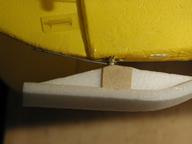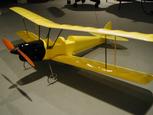
I discovered electric powered RC airplanes in July this year and received a GWS Pico Tiger Moth as a gift in late August. It has been a great plane from which to learn to about the electric flight hobby. The Tiger Moth is a WWII biplane trainer. The model incorporates wing dihedral with rudder, elevator, and motor speed control, requiring a 3-channel transmitter.
For more
information on the Tiger Moth history and photos of the real thing is avaiable at the following links:
www.geocities.com/CapeCanaveral/Lab/3455/tigermoth.html.
www.airliners.net --search for dh82 in the airplane selection box. Very nice photos of lots of airplanes.
sres.anu.edu.au/associated/fpt/nwfp/tigermoth/tigermoth.html
www.dhmothclub.co.uk/
www.duncanhutson.co.uk/your_model.htm
The kit comes with a GWS DX-A motor geared at 5.9:1 turning a 9x7
prop. To the basic kit, you must add a receiver, battery pack,
speed controller, and two servos. GWS markets two kits of all
the necessary flying electronics: a Naro and a Pico. The
electronics kits differ in the size of the servos (the Pico kit uses
smaller servos) and the size and length of the receiver antenna (the
Pico kit’s antenna is thinner wire and is one-half the length of
the Naro’s receiver antenna. The supplied battery pack is
a 150mAh 6-cell NiCd pack (7.2 volts).
When assembling the model, pay attention to the alignment of all components. I didn't keep the fuselage straight when I glued it together. It has a slight bend (like a banana) that causes the rudder to be slightly offset. As a result, I have to use a little right rudder to make my TM fly straight.
Make sure the tail pieces are at 90-degrees to each other and that the horizontal stabilizer will be even with the wings when the wings are mounted.
I performed a number of modifications to the kit during and after
assembly:
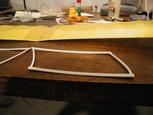
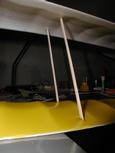

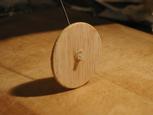
Other modellers have replaced the stock landing gear with removable gear, sometimes made from CF rod. The major reason for using removable landing gear is to allow the fuselage to be removed from a wing that uses flying wires (typically made from fishing line) to stiffen the wings.
Reading about airplanes on the web really helped me get started.
I now know why all the small balsa gliders and rubber powered
airplanes I built as a child never flew well – they
weren’t properly balanced. After starting to fly, I found that
when I glued the fuselage halves together, I didn’t keep the
fuselage straight. It has to have the rudder trimmed slightly to
the right to fly straight.
Small electric airplanes fly much better when they are light and the
Tiger Moth is no exception; it weighs 199 grams (7.1 oz) without
battery. But light also means that they can’t fly when the
wind picks up. Wind over about 5mph makes for very slow up-wind
legs and any gusts make safe landings very interesting.
The performance of the Tiger Moth out of the box is good, but can be easily improved. I've been using the 10x4.7 prop with good success. It is the prop that is noted on DX-A motor package as being the best match. My static thrust measurements show the 9x7 prop with about 90 grams of thrust and the 10x4.7 at over 100 grams of thrust (my guage measures up to 100 grams). The result is that the 10x4.7 prop performs better for at low speeds such as at takeoffs and at stall speeds.
Other pilots report that the 9x7 prop moves more air and provides more thrust in flight, even though the 10x4.7 provides more thrust when measured in static tests on the ground. At high altitudes, other pilots report success in using a 10x7 prop. Some pilots have taken the 10x4.7, heated the blades, and bent them to the 7 inch pitch when they cannot find the appropriate diameter and pitch prop at the local hobby shop.
There are two types of electric motors available for use in the GWS DX series systems. One motor, using a black plastic rear housing, uses a wiper brush made of metal. The other motor type, built with a gray plastic rear housing, uses carbon brushes. The carbon brushes last a lot longer than the metal brushes. Replacement motors (with or without the gearbox) are available from a variety of sources. I purchase most of mine from Todds Models.
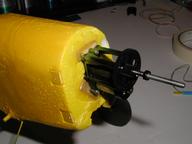 The stick that the GWS motor is mounted on broke in a particularly bad
nose-in crash. I had been wanting to change the motor offset anyway
and took this opportunity to mount 1/32-inch plywood to the front of
the firewall using epoxy. I screwed the motor to the plywood using
small wood screws that come with some of the DX-A motors and with the
smaller servos from various vendors. I can now shimm the motor to
whatever offset I'd like. I'm currently using a fair amount of
down-thrust.
The stick that the GWS motor is mounted on broke in a particularly bad
nose-in crash. I had been wanting to change the motor offset anyway
and took this opportunity to mount 1/32-inch plywood to the front of
the firewall using epoxy. I screwed the motor to the plywood using
small wood screws that come with some of the DX-A motors and with the
smaller servos from various vendors. I can now shimm the motor to
whatever offset I'd like. I'm currently using a fair amount of
down-thrust.
I've also experiemented with batteries. Changing to a 7-cell battery pack provided a welcome improvement in full-throttle thrust. I don't consider the 6-cell 150mAh NiCd pack to be worth buying. I tried 8-cell packs and found that the motor life is significantly reduced when running at the higher voltages (the brushes quickly die).
I also invested in some 600-700 mAh NiMH batteries. These batteries weigh about 100 grams (3.5 oz), twice that of the 150mAh NiCds, but with 5 times the capacity. I've gotten flights of 25 minutes on these batteries. It is a lot of fun to practice a lot of touch-and-gos at the local baseball infield without having to change batteries!
I recently purchased 550mAh lithium-ion battery cells that weigh 20 grams each. A two-cell pack provides 7.6 volts, equivalent to a 6-cell NiCd pack) and weighs 41 grams. It drives the Tiger Moth very well, even though the voltage is equivalent to a 6-cell NiMh pack. The reason it flys well is because the battery weight is so small. NOTE: Lithium Ion batteries have special charging requirements. Please read up on them before buying and charging them.
Another very good batery choice is the 830mAh Lithium Ion cell, also
taken from cell phone battery packs. Two cells provides 7.6 volts
(6-cell NiCd pack equivalent) and weighs about 61 grams. It is easy
to get 20-30 minute flights with these packs.
It snowed here last week and I decided to try skis on my TM. Here are
the photos of the skis I made using the foam from construction board
purchased at a local office supply store (soak the foam to remove the
cardboard backing). I even made the rear ski steerable. The main
skis are 6 x 1 inch and the rear ski is 4 x 3/4 inch. The mains were
too narrow for very soft snow. I increased the width to 1-3/4 inches
and they rode on the snow better. Flying from packed snow will always
be better. I had to add thread from the leading and trailing edges of
the skis to the wing hold-down dowel at the front of the wing.
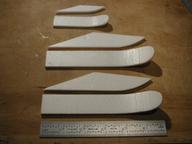
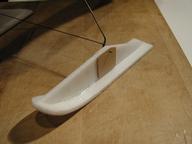

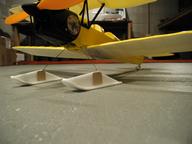
The tail wheel (ski) is constructed from a 5/32 brass tube epoxied
into a hole drilled into the tail foam. The wheel (ski) is mounted on
a piece of bamboo skewer. A .025-inch hole is drilled through the
bamboo and a piece of .025-inch wire is glued into the hole. A slight
kink in the end of the wire helps hold it in the hole in the
bamboo. The wire is taped onto the rudder with clear packing tape. The
wire flexes back and forth in the loop of tape and doesn't stick. If
the tape causes a problem, I intend to tape a piece of small tubing to
the bottom of the rudder. I didn't glue a tube to the rudder so it is
easy to change the wheel to a ski.
